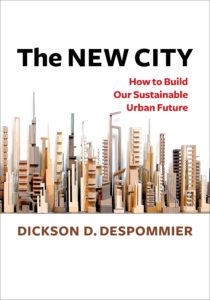The New City
How to Build Our Sustainable Urban Future
by Dickson D. Despommier
Praise for The New City
“Dickson D. Despommier paints a picture of the future city, where carbon sequestered in buildings, vertical farms, recycled water from the air, circular economies for waste, and renewable energy provide urban dwellers with their needs and wants. His argument that our species can only persist by refashioning cities around the realities of nature rings true in today’s perilous world. “
— Ruth DeFries, Denning Family Professor of Sustainable Development, Columbia University, and author of What Would Nature Do?
“In The New City, Dickson Despommier conjures a future of totally sustainable ‘off-grid’ cities. A high degree of self-sufficiency in energy, water, and food will ensure quality of life for the urban population (more than two thirds of the planet by the 2040s) while taking a great deal of pressure off the non-urban environment, providing a path to surviving climate change. The narrative depends on ambitious technical and policy assumptions, but Despommier has credibility as a visionary, given his broad ecologist’s perspective and his successful record of defining the emerging urban agriculture/vertical farming sectors. This is a profoundly optimistic vision of cities inspired by and synchronized with nature.”
—Gregory Kiss, Kiss + Cathcart, Architects
“How can we re-consider infrastructure to better serve our urban centers? Climate resiliency isn’t just an environmental issue, it’s a social justice issue, a public health issue and an economic resiliency issue. We need solutions that address all four. Dickson’s timely book helps us answer this question holistically, addressing the fact that sustainable communities are indeed successful ones. But most importantly, Dickson’s new work reminds us of the necessity of action.”
–Nona Yehia, Co-Founder & CEO, Vertical Harvest
“The science of bad climate news is ever present but in this wondrous new work by Dickson Despommier, we see the good news for the future might well be found in the rethinking and redesign of our cities.”
–Robert Fullilove, Professor
Mailman School of Public Health, Columbia University
“Each change in the evolution of human history begins with a voice that sees the world differently. Not the way it is, but the way it could be. Dickson is one of these people, and he has spent much of his career advocating for a sustainable ecology based on human health and a sensible approach to food production.”
–Scott Erdy FAIA, Design Principal, Erdy McHenry Architecture
Visiting Lecturer, University of Pennsylvania
“Dickson Despommier has done it again, and this time he goes higher toward the goal of feeding our growing global urban population with innovation, examples and leadership. Farming inside cities is a critical part of feeding billions of people and thanks to this new book we have a renewed vision of how to get there.”
–Josh Tickell, author of Kiss the Ground
About the Book
From the pioneer of vertical farming worldwide, THE NEW CITY draws on a unique concept called biomimicry, a bold vision of what nature can teach us about the best way to grow food, store carbon, harvest rainwater, and renew energy for the cities of the future. By the year 2050, 70 percent of humans will live in cities. Yet not a single urban center on Earth is completely off the energy/water/food grid (i.e. self-sufficient), despite recent technological advances that can make that happen. Cities rely on farmland hundreds to thousands of miles away to survive, and many countries are already forced to import the majority of their food from other global regions. The situation with fresh water is even more dire, to say nothing of countless other long-term threats from unchecked climate change. THE NEW CITY presents a new unified theory of sustainable urban environment centered on the concept of biomimicry—making our built environment behave similarly to the trees of temperate zone forests, which produce food, store carbon in their roots and branches, harvest rainwater, and convert sunlight into chemical energy via photosynthesis. If a city were to incorporate these same functions into its infrastructure, instead of being parasitic on the surrounding landscape, it would begin to support the recovery of damaged ecosystems by becoming self-sufficient. This would be the first book to explore the concept of biomimicry as a window into how the built environment of the new city of the future can emulate what nature does, and become an asset to our global environment instead of a blight upon it.
About the Author
Dickson Despommier spent 38 years as a professor at Columbia University, where he won the Best Teacher Award six times and received the national 2003 American Medical Student Association Golden Apple Award for teaching. The author is a seasoned public speaker, having addressed professional audiences at The United Nations, the American Institute for Architecture, The Indian institute for Architecture, and leading universities throughout the world. He has given a TED talk and many TEDx talks – Washington D.C., Chicago, Bermuda, and New York City. He has been a plenary session invited speaker at Seeds and Chips in Milan, GreenTech in Amsterdam, Agriculture 2.0 in New York City, and at AessenceGrows in Shanghai. He was a judge of architectural student projects in Singapore, and was invited as an expert in urban agriculture by the City of Paris for their Reimagining Paris conference. Despommier is a veteran of appearances on NPR, The Colbert Report and The Discovery Channel, and has been featured in CNN, Forbes, CNBC, The Economist, AP and the New York Times. He also spoke at Pop!Tech in Camden, Maine, and five consecutive years at the World Science Festival in New York. Dickson is also a veteran speaker and commentator on environmental issues, and has appeared on major media, most recently on CBS Sunday Morning.

Columbia University Press